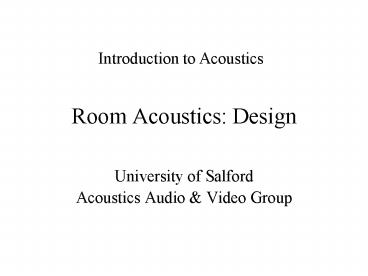Room Acoustics: Design - PowerPoint PPT Presentation
1 / 13
Title:
Room Acoustics: Design
Description:
... 2.5 m high, the floor is covered with carpet of a = 0.6, the ceiling has an a ... The ceiling is covered with absorptive tiles and the floor with thin carpet. ... – PowerPoint PPT presentation
Number of Views:138
Avg rating:3.0/5.0
Title: Room Acoustics: Design
1
Room Acoustics Design
Introduction to Acoustics
- University of Salford
- Acoustics Audio Video Group
2
Learning Outcomes
- Explain absorption coefficient, total absorption
and use in Sabine calculations - Explain direct and reverberant sound pressure
level room radius - Predict reverberation time for a room design
using tabulated absorption data.
3
Absorption Coefficient
a is a function of frequency angle of incidence
4
Total Absorption
The total absorption, A, in a room is given by
Where each surface has a surface area Si and a
random incidence absorption coefficient
5
Example 1
In a room 4 m x 3 m x 2.5 m high, the floor is
covered with carpet of a 0.6, the ceiling has
an a 0.2 and the walls have an a 0.3.
What is the total absorption in the room? What
is the reverberation time?
6
Reverberation and sound pressure
- We already know that
- How does D relate to things we already know, like
pressure and Lp? - ( it can be shown that) for a reverberant sound
field,
7
Reverberant sound pressure level
- Starting from
- we find
8
Example 2
A busy swimming pool is 60 m by 30 m by 15 m
high. In the pool area, the reverberant sound
pressure level in the octave band centred on 1
kHz is 74 dB and the reverberation time is 4.0
s. By how much will the sound pressure level be
reduced if 1000 m2 of absorption is added to the
ceiling?
9
Reverberant direct Lp
L
p
,
t
o
t
a
l
)
B
d
(
L
p
L
p
,
r
e
v
L
p
,
d
i
r
r
o
o
m
r
a
d
i
u
s
r
(
m
)
10
Decay of Lp
- From relationship between D and p, we can convert
D of decaying sound into Lp - Note the straight line
11
Worked Design Example
A lecture theatre measures 16 m by 13 m by 5 m
high. The ceiling is covered with absorptive
tiles and the floor with thin carpet. All the
walls have a plaster finish. Calculate the
reverberation time in octave bands when the room
is occupied by 100 students. Absorption
coefficients
12
Example RTs
Outdoors 0.0 Average bedroom / living
room 0.4 Theatre for speech 0.9 Glyndebourne
Opera house 1.3 St David's Hall Cardiff
2.1 (concert hall) Symphony Hall
Birmingham 2.4 (concert hall) St. Paul's
Cathedral 13
13
Conclusions
- A sound source in a room produces a direct level
and a reverberant level - Absorption can be used for noise control in a
reverberant room - Reverberant decays in dB should be straight
- Sabines equation can be used to predict RT for a
room not yet built.































